CM.com Bundle
From Nightclubs to Global Cloud: How Did CM.com Evolve?
Imagine a company born from a simple text message, evolving into a global force in cloud communications. This is the captivating CM.com SWOT Analysis story, a journey that began with a revolutionary idea in the late 1990s. Discover how CM.com, initially focused on SMS marketing, transformed itself, shaping the landscape of customer interaction across diverse industries.
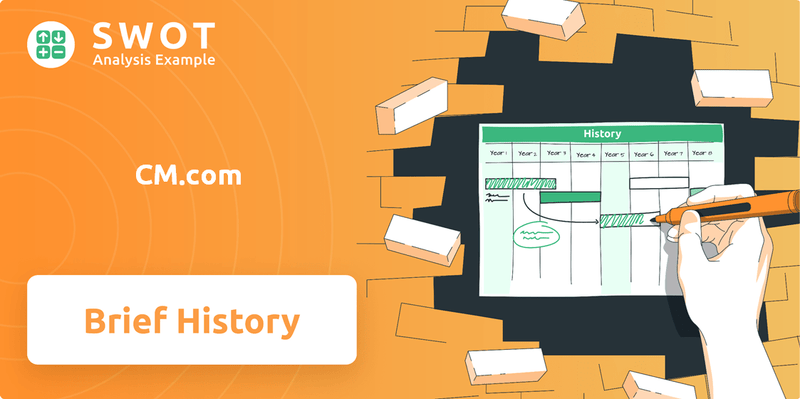
Delving into the CM.com history reveals a tale of innovation and adaptation, from its CM.com company background rooted in nightclub promotions to its current status as a leader in AI-powered customer engagement. This CM.com timeline showcases the company's strategic pivots, key milestones, and its commitment to staying ahead in the ever-changing tech landscape. Understanding the CM.com founder vision and early years is essential to grasping the full scope of what does CM.com do and its impact on the modern business world.
What is the CM.com Founding Story?
The story of CM.com, a prominent player in the cloud communications sector, began in February 1999. The company, initially known as ClubMessage B.V., was founded by Jeroen van Glabbeek and Gilbert Gooijers in Breda, Netherlands. This marked the start of what would become a globally recognized business.
The founders identified an opportunity in the emerging mobile technology landscape. They saw the potential of SMS messaging for business applications. Van Glabbeek, leveraging his engineering background, developed the initial software. This laid the foundation for the company's future growth.
The primary goal was to solve the inefficiencies of nightclub promotion. They aimed to replace paper flyers with SMS messages. This allowed clubs to inform patrons about events and promotions.
- The initial business model involved collecting phone numbers from club visitors.
- SMS messages were then used to send out invitations for future events.
- Within a few years, ClubMessage was reaching nearly a million young people weekly.
- They served a thousand discotheques across the Netherlands and Belgium.
The name 'CM' originated from 'Club Message,' reflecting the company's initial focus on the club scene. This early strategy proved successful. The company's focus on mobile messaging and its direct engagement with the nightlife sector helped it gain a strong foothold in the market. The founders bootstrapped the initial funding, leveraging their direct engagement with nightlife venues. This approach allowed them to quickly establish a presence and build their business model. For a deeper dive into how the company has evolved its strategies over time, you can explore the Marketing Strategy of CM.com.
CM.com SWOT Analysis
- Complete SWOT Breakdown
- Fully Customizable
- Editable in Excel & Word
- Professional Formatting
- Investor-Ready Format
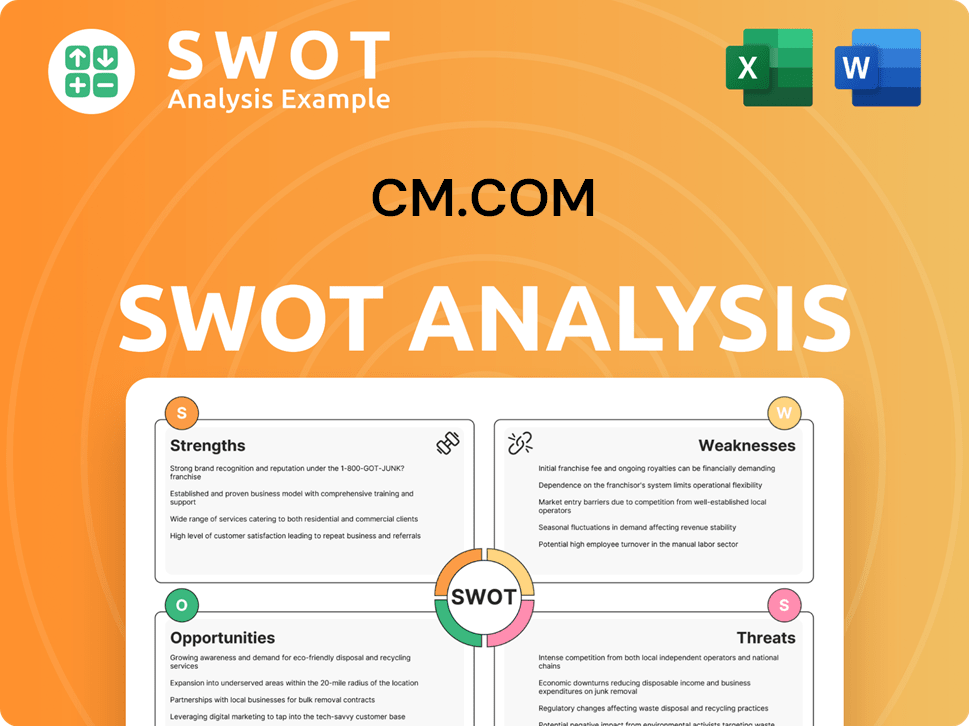
What Drove the Early Growth of CM.com?
The early growth of the CM.com company was marked by a rapid expansion of its SMS messaging services. This expansion quickly moved beyond its initial focus, reaching major events and festivals in several European countries. A significant early innovation was the introduction of 'Mail SMS' in 2002. The CM.com timeline shows a consistent growth trajectory.
By 2001, CM.com expanded its SMS services to major events and festivals in the Netherlands, Belgium, and Luxembourg. The introduction of 'Mail SMS' in 2002, a patented service, further solidified its position. In 2006, the adoption of its SMS voting service by major television shows, including the Eurovision Song Contest, boosted its presence. This period also saw the company recognized on Deloitte's Technology Fast 50 list.
From 2010 to 2019, the company pursued strategic acquisitions and international expansion. Key acquisitions included the SMS portfolio of Mobillion in 2010 and MobileWeb in 2012. Further acquisitions in 2013 included Paratel and SMSHosting. Geographical expansion accelerated in 2015 with new offices and the acquisition of SMS Trade.
In 2015, the company founded CM Payments, entering the mobile payments market. The acquisition of TicketFlow in 2016 marked its entry into the ticketing market. The company transformed from an SMS supplier into an integrated platform, offering various software solutions. Efforts to improve internal processes and service quality were also significant.
By the end of 2024, CM.com reported a total gross profit of €83.1 million. The company's financial performance included Annual Recurring Revenues of €33.7 million. The company processed €2,818 million in payments, 19.3 million tickets, 8.3 billion messages, and 246.5 million voice minutes. For more details, you can read the article about the CM.com company background.
CM.com PESTLE Analysis
- Covers All 6 PESTLE Categories
- No Research Needed – Save Hours of Work
- Built by Experts, Trusted by Consultants
- Instant Download, Ready to Use
- 100% Editable, Fully Customizable
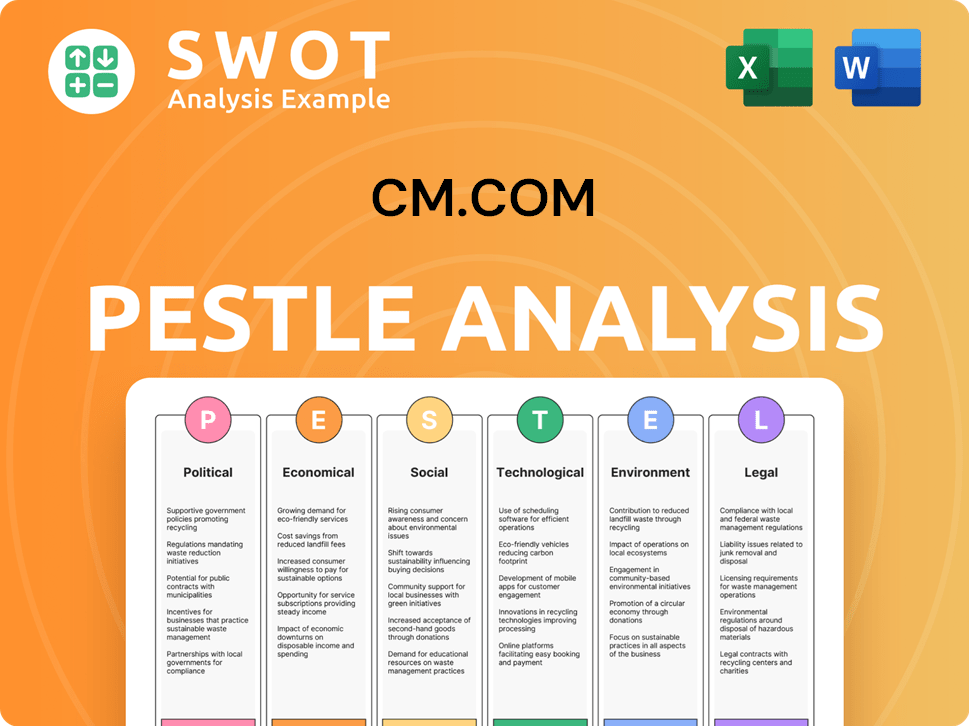
What are the key Milestones in CM.com history?
The CM.com history is marked by significant achievements and strategic shifts. From its early days as an SMS provider to its current status as an integrated platform, the company has consistently adapted to the evolving technological landscape.
| Year | Milestone |
|---|---|
| 2002 | Patented the Mail SMS service, a foundational innovation. |
| 2006 | Provided SMS voting services for major broadcasts, including the Eurovision Song Contest. |
| 2017 | Acquired Docdata Payments, expanding into the payment institution market. |
| 2022 | Acquired Building Blocks, enhancing its AI capabilities. |
| Q3 2023 | Launched its Generative AI Engine, demonstrating its strengths in AI. |
| Feb 2025 | Acquired GUTS Tickets, strengthening its ticketing presence. |
| Q1 2025 | Introduced its Agentic AI platform, HALO, securing nearly 100 deals. |
| July 2024 | Introduced solutions like card payments without an internet connection. |
CM.com's innovations have been pivotal in its growth and market positioning. The company has been among the first to launch RCS in Germany and the Netherlands, and has added WeChat Pay and Apple Pay to its platform, improving its services.
The patented Mail SMS service in 2002 was a key early innovation for CM.com, setting the stage for future developments. This technology helped establish the company's initial foothold in the mobile communications market.
CM.com's SMS voting service, used for major events like the Eurovision Song Contest in 2006, showcased its early capabilities in broadcasting. This service highlighted the company's ability to handle high-volume, real-time transactions.
The launch of cloud solutions, including the Mobile Marketing Cloud and Mobile Service Cloud, marked a significant step in CM.com's transition. These platforms provided enhanced tools for customer engagement and service delivery.
Being among the first to launch RCS in Germany and the Netherlands demonstrated CM.com's commitment to adopting advanced messaging technologies. This initiative improved user experience and enriched communication capabilities.
The launch of the Generative AI Engine in Q3 2023 and the Agentic AI platform, HALO, in Q1 2025, shows a strong focus on AI. This integration aims to enhance efficiency and improve processes across the company's ecosystem.
The introduction of card payments without an internet connection in July 2024 expanded CM.com's payment solutions. This innovation provided greater flexibility and convenience for users.
Despite its successes, CM.com has faced several challenges. Market volatility in transactional businesses impacted the company's performance in Q1 2025, although profitability increased.
The transactional business experienced market volatility, affecting topline performance in Q1 2025. Despite these challenges, CM.com managed to increase profitability during this period.
Adapting to changes in the technology landscape, including the shift from SMS to richer messaging channels, presented a challenge. CM.com has responded by integrating new technologies like RCS.
Strategic acquisitions, such as Docdata Payments in 2017 and GUTS Tickets in February 2025, expanded CM.com's offerings. These moves helped the company enter new markets and strengthen its existing services.
Integrating AI deeply across its ecosystem to enhance client efficiency and internal processes is a challenge. CM.com aims to become an 'AI-First' company.
CM.com became EBITDA positive by the end of Q3 2023, demonstrating resilience. Despite market fluctuations, the company has shown its ability to maintain and improve financial health.
Navigating the competitive landscape in the cloud communications and payment solutions markets is a constant challenge. CM.com needs to stay ahead by innovating and adapting to market demands.
CM.com Business Model Canvas
- Complete 9-Block Business Model Canvas
- Effortlessly Communicate Your Business Strategy
- Investor-Ready BMC Format
- 100% Editable and Customizable
- Clear and Structured Layout
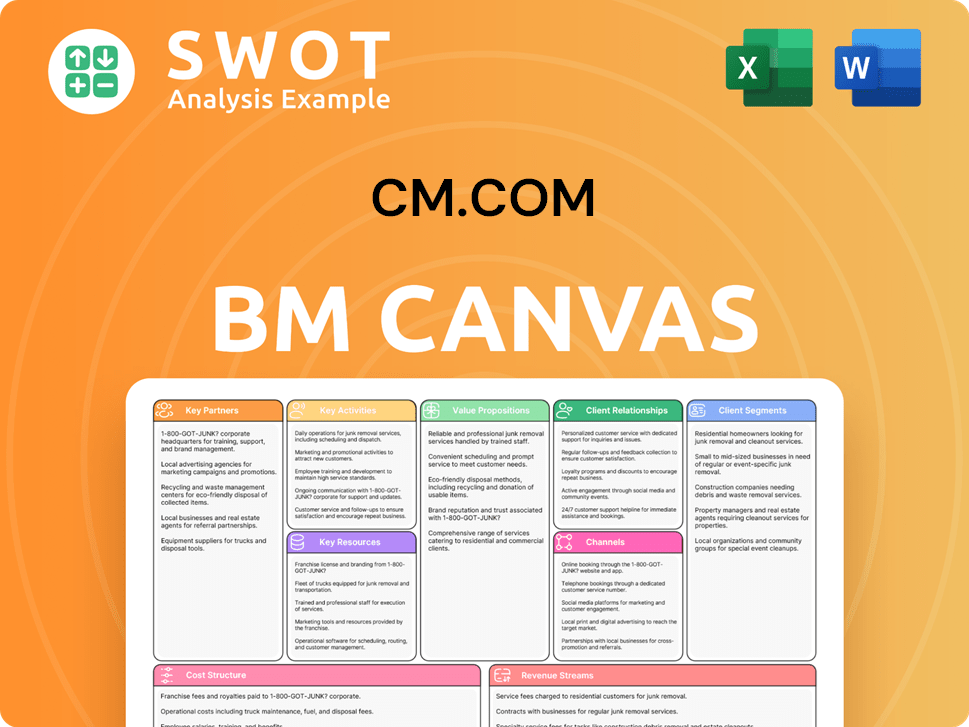
What is the Timeline of Key Events for CM.com?
The journey of CM.com began in 1999, evolving from a focus on SMS marketing for nightclubs to a global leader in cloud communications and payment solutions. The company's history is marked by strategic acquisitions, technological innovations, and expansion into new markets, reflecting its adaptability and commitment to leveraging mobile technology.
| Year | Key Event |
|---|---|
| 1999 | ClubMessage, later CM.com, is founded in Breda, Netherlands, by Jeroen van Glabbeek and Gilbert Gooijers. |
| 2002 | Introduction of Mail SMS, a patented service. |
| 2006 | CM.com's SMS voting service is utilized for the Eurovision Song Contest. |
| 2013 | Acquisitions of Paratel, OneSixty Mobile, and SMSHosting expand services and establish a UK presence. |
| 2015 | CM Payments is founded and offices open in the UK, France, and Germany. |
| 2016 | Entry into the ticketing market with the acquisition of TicketFlow; offices open in South Africa and Hong Kong. |
| 2017 | Acquisition of Docdata Payments, expanding into payment processing. |
| 2019 | Becomes an 'Official Event Supporter' of the Formula 1 Heineken Dutch Grand Prix. |
| 2020 | CM.com goes public on Euronext Amsterdam. |
| 2022 | Acquires consumer AI technology company Building Blocks. |
| 2023 | Launches Generative AI Engine and achieves EBITDA positive status by Q3. |
| 2024 | Reports €83.1 million in total gross profit and €274.25 million in annual revenue; introduces four new Business Units. |
| Q1 2025 | Launches Agentic AI platform HALO and reports a 63% higher EBITDA year-over-year. |
| May 2025 | Unveils improved financial targets and introduces Voice AI Agents. |
CM.com is deeply committed to its 'AI-first' strategy. This involves integrating Generative AI across its ecosystem. The company aims to become a leader in AI-powered customer engagement solutions.
For FY 2025, CM.com has set an EBITDA target of €22-27 million. This forecast reflects expectations of gross profit growth and stable OPEX. The company anticipates further margin growth in its engaged business unit.
The company plans further investments in customer support and AI-driven operational enhancements. These investments are designed to support the ongoing development of AI-based software solutions.
CM.com's long-term vision remains focused on leveraging mobile technology for global communication, interaction, and payments. The company is focused on the future of advanced AI and its impact on the industry.
CM.com Porter's Five Forces Analysis
- Covers All 5 Competitive Forces in Detail
- Structured for Consultants, Students, and Founders
- 100% Editable in Microsoft Word & Excel
- Instant Digital Download – Use Immediately
- Compatible with Mac & PC – Fully Unlocked
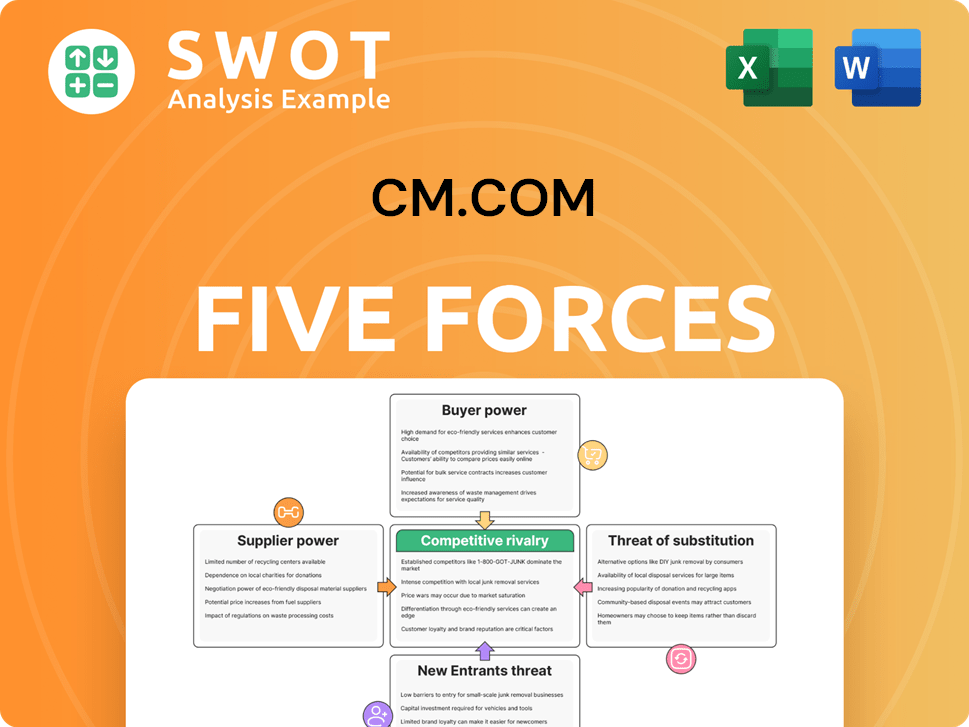
Related Blogs
- What is Competitive Landscape of CM.com Company?
- What is Growth Strategy and Future Prospects of CM.com Company?
- How Does CM.com Company Work?
- What is Sales and Marketing Strategy of CM.com Company?
- What is Brief History of CM.com Company?
- Who Owns CM.com Company?
- What is Customer Demographics and Target Market of CM.com Company?
Disclaimer
All information, articles, and product details provided on this website are for general informational and educational purposes only. We do not claim any ownership over, nor do we intend to infringe upon, any trademarks, copyrights, logos, brand names, or other intellectual property mentioned or depicted on this site. Such intellectual property remains the property of its respective owners, and any references here are made solely for identification or informational purposes, without implying any affiliation, endorsement, or partnership.
We make no representations or warranties, express or implied, regarding the accuracy, completeness, or suitability of any content or products presented. Nothing on this website should be construed as legal, tax, investment, financial, medical, or other professional advice. In addition, no part of this site—including articles or product references—constitutes a solicitation, recommendation, endorsement, advertisement, or offer to buy or sell any securities, franchises, or other financial instruments, particularly in jurisdictions where such activity would be unlawful.
All content is of a general nature and may not address the specific circumstances of any individual or entity. It is not a substitute for professional advice or services. Any actions you take based on the information provided here are strictly at your own risk. You accept full responsibility for any decisions or outcomes arising from your use of this website and agree to release us from any liability in connection with your use of, or reliance upon, the content or products found herein.